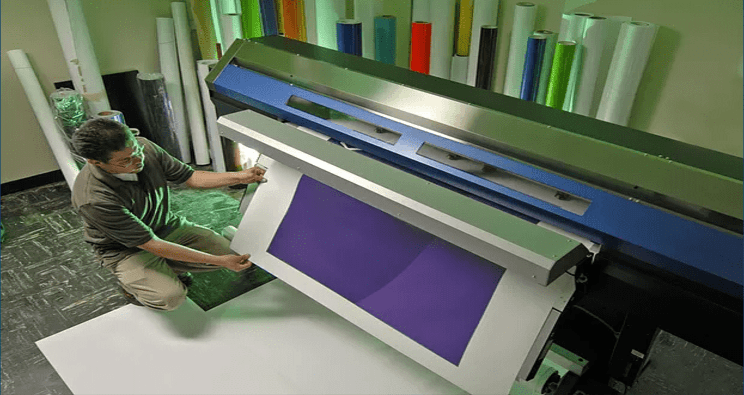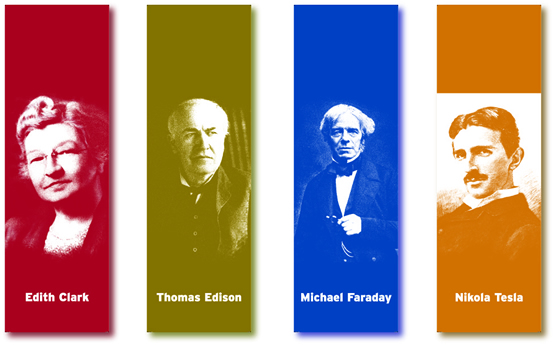Dye Sublimation Silk Banner Flags and Satin Fabric Banners Wholesale for Bulk Orders, Resellers, Brokers
Our wrinkle free Silk and Satin Fabric Banners are printed using dye sub fabric printing on Ultra-smooth Polyester Silk and Satin Cloth Fabric and feature beautiful photo quality. These custom canvas banners are an outstanding choice for conventions, office, store or showroom interiors and trade show exhibits.
What is Sublimation Printing
 Dye sublimation printing is a heat-transfer process, whereby a graphic is printed in reverse on a special transfer paper and heat-transferred while applying high pressure to polyester fabrics. After the paper is printed, the ink/paper is heated to 400+ degrees (sublimation temperature for satin) and using pressure on the paper/ink/fabric, the ink turns into a gas and “sublimates” itself into the fabric – hence the term dye sublimation.
Dye sublimation printing is a heat-transfer process, whereby a graphic is printed in reverse on a special transfer paper and heat-transferred while applying high pressure to polyester fabrics. After the paper is printed, the ink/paper is heated to 400+ degrees (sublimation temperature for satin) and using pressure on the paper/ink/fabric, the ink turns into a gas and “sublimates” itself into the fabric – hence the term dye sublimation.
Compared to direct solvent print to fabric, the dye sublimation process provides more vibrant colors and a photo-clear definition. Another advantage of the dye sub fabric printing process is that these fabric banners are machine washable on a gentle cycle with mild detergent. You can’t do this with solvent-printed fabrics.
Product Features and Options
 Fabric Sublimation Printing on 3.2 oz. Silk or Satin Banner Material is available with the following options:
Fabric Sublimation Printing on 3.2 oz. Silk or Satin Banner Material is available with the following options:
- FREE set-up on most banner printing
- Hot knife edge-finishing
- Hems and/or Grommets
- Pole Pockets
- Hem Reinforcing
- Design Services
- Ship in approx. 3 to 5 working days
- Rush Orders & Expedited Shipping
- Note: We cannot guarantee exact color matching for all Pantone™ colors
Where to Use Poly Satin Fabric Banners
Dye sublimation 3.2 oz. Polyester Satin and Silk Cloth Banners are mainly used for:

- Trade Show Displays
- Interior P.O.P. Displays
- Backdrops (Satin Fabric Backdrop)
- Inside Store Product Promotions
- …and more!
Testimonial
OMG The banners came out FANTASTIC!!! I just can’t get over the color on them and how nice they look… Big kudos to you and your team! Please pass along how happy I am! :) Thank you again SO much…I’m already happily planning next year’s order ( but hopefully we won’t have to rush you next time lol).
– Kellee at KelleeArt Design, FL

Get a Quote Now!
Visigraph is a wholesale domestic and import broker, and therefore, we require a minimum order of $500USD for ALL wholesale orders.
All fields marked with star (*) are required.
Large Quantity Quotations
If you need banner fabric by the yard or large quantities of poly silk or poly satin dye sub fabric banners, call us at 509-483-8000, email our sales department directly at sales@visigraph.com, or fill out our Get A Quote form.
The Visigraph 100% Satisfaction Guarantee
We pay careful attention to every detail on every order we receive, and our 100% Satisfaction Guarantee is just what it says…you’ll love our silk and satin banner printing or we’ll re-do them. It doesn’t happen often, but hey, we’re human too! Rest assured, though, that if it does, we’ll fix’em free of charge and with no hassle.
Calculating the Size of your Poly Satin/Silk Fabric Banner
Height x Width = Number of Square Feet. For example, if you have a banner that is 5ft. x 5ft.- 5 x 5 = 25 square feet

The Polyester Fabric
Natural fibers cannot be used in the print process due to their cellular structure and the chemistry of dye sublimation. Polyester fabric is very stain resistant, and only certain specialty dyes are able to permanently color the fabric.
Polyester is a woven fabric that is polymer-based. Some polyesters are plant-based from naturally occurring chemicals, although they are in the minority. Some of these naturally occurring polyesters, and a few synthetic ones such as polybutyrate, are biodegradable, but most are not. Some polyesters are “thermoplastics,” and these are the type used in polyester fabric.
Polyesters have also been made to mirror natural fibers. An example is “polysilk” fiber, obviously mimicking silk. Polyknits have been used for 50+ years, but now can emulate cotton or wool or taffeta or other natural or synthetic fibers, often with superior durability.
What is Dye Sublimation
Dye sublimation printing uses heat and pressure to transfer the CMYO print from the transfer paper to the synthetic fabric itself. Sublimation simply means that the dyes convert from a solid state to a gaseous state, although never becoming liquid. The process was developed to be able to transfer photographs and highly intricate designs onto fabric or cloth.
Most dye sublimation printers use CMYO printing colors (Cyan-Magenta-Yellow-Overcoating) which is different from inkjet banner printing (on vinyl or fabric) which uses CMYK (cyan-magenta-yellow-black) because the black is eliminated and the clear overcoat is used instead.
This overprint is both a UV protectant and helps to create a water-resistant coating for polyester banners and displays, t-shirts, table covers, sportswear, flags, and other items that require high definition printing.
An image or photograph is sent to the printer, and it prints the image, in reverse, onto a sheet of transfer media, a treated paper. It is then “married” to the chosen fabric, and sent through another unit with heated pressure rollers. These rollers heat up to around 400F, and with the heat and the pressure, the polymer cells in the fabric opens, the dye changes from a solid to a gas and fuses itself to the polyester fabric, creating a continuous tone print much like a photograph. And then once it cools down after going through the heated rollers, the polymer cells close, permanently holding the infused dyes within the fabric.
Advantages of Using Dye Sub Fabric Banners
Over the past few years, digital direct to substrate dye sublimated printing has started to take over the fabric banner industry because it has less steps involved in printing a banner using dye sublimation that the heat and pressure method. I.e., it’s faster and cheaper to produce, so many printers are switching to this type of printer for those reasons.
The difference between most printing and dye sublimation fabric printing is that most printing, including screen printing, and all types of digital printing, use a dot pattern to create color, whereas dye sublimation cloth printing has a continuous tone, just like pictures that you get developed from your camera.
The printing process is somewhat like photo printing in that the tones are continuous, unlike the dot pattern of an inkjet printer. This also is what creates the richness of color, tone, and continuity in dye sublimation printed fabric graphics that catch everyone’s eyes.
It also permanently infuses the poly fabric with color during the print process so that you can send these banners through the washer without color loss. You can wash it or display it outdoors under the rain.
The images don’t peel or fade (permanency), the colors can be brilliant due to the amalgamation of the dye to the fibers of the polyester or other synthetic fabric. These images also can be printed all the way to the edges of the fabric.
If you are at a competitive trade show, or similar, and your competitors have some nice graphics on vinyl or the like, and you show up with your continuous tone printed fabric display, you are going to win the subliminal war. Face it, if your display looks rich, and theirs looks middle-class, they’ll get some clients, maybe lots, but you’ll land the best clients at better margins.
The image is a part of the fabric, so it doesn’t peel off like ink on the surface of fabric or other materials and will not fade for many years. The dye cannot build up on fabric like t-shirts either. Everyone had worn a printed shirt where the ink felt like it was very stiff on the surface of the material, and over time it will begin to flake off. This will not happen with dye sublimation.
Banner Care
If you can’t fit the banner or banners in your washer, then you’ll need to manually wash them, whether when you’re hanging them or washing them in a large tub or barrel. No matter which route you take, make sure your detergent is tough against grease.
Once you’ve washed your dye sub cloth banners, the best practice is to hang them up to dry. If you don’t have this option, and they’ll fit in a dryer, go ahead and dry them that way. Make sure you don’t leave them in the dryer once it stops, as it’ll create wrinkly banners, and it’s not a lot of fun ironing them out.
Once the fabric banner has dried, you can also use an iron on low heat to iron out any wrinkles that may have occurred in the drying process. Now you have a bright and clean banner to hang up at your next show!
Banner Durability
The ink being washed off either a vinyl banner or a cloth banner should never be an issue.
A flag on a pole, like a country or state flag, has an average life of 6 to 12 months. A banner flag tacked to a wall may last years, though, as the wind will have little affect. On the north side of a building, this banner may last five or ten years. On the south side, west side, or east side, the sun will reduce that banner flag’s longevity, maybe up to 50% or more.
Wind is the biggest enemy of banner longevity. Most digitally printed banners, though, should, if properly installed, last at least 3 years outdoors, though I’ve seen them last 10 years in the case of one very cheap client. There is not much you can do to protect a banner from the sun, but a good quality ink should keep them lasting as long as you’ll need them to advertise your company or event.
Popular Posts Related to the Products:


